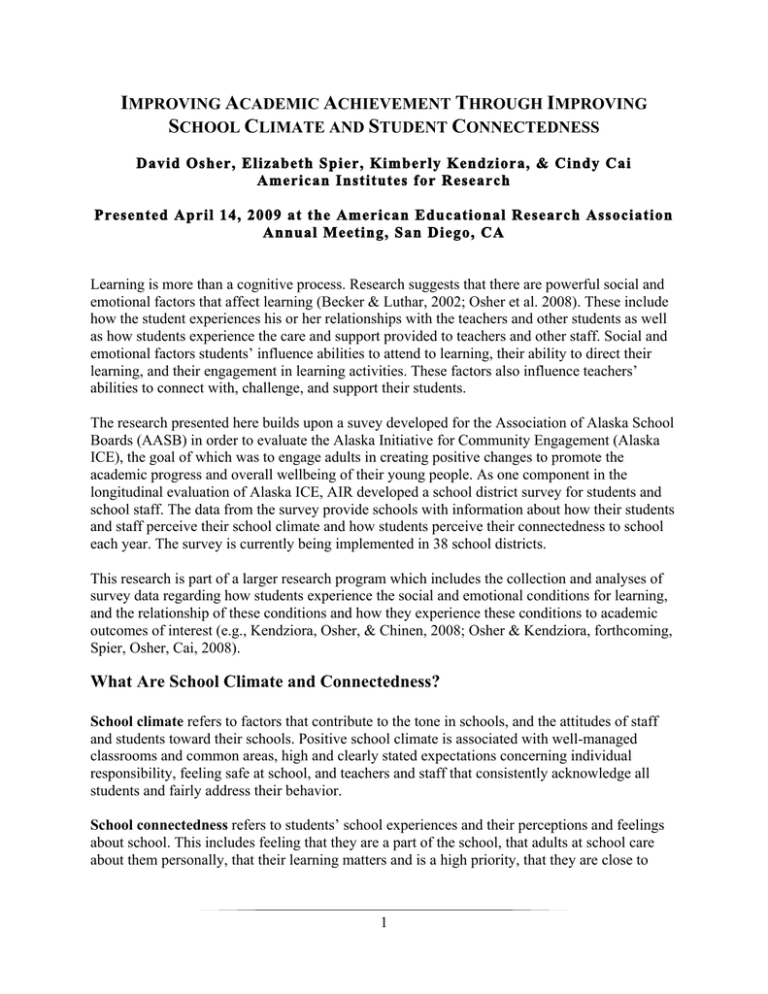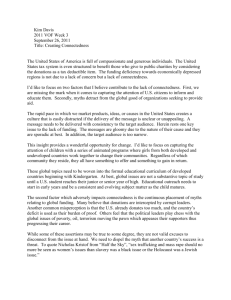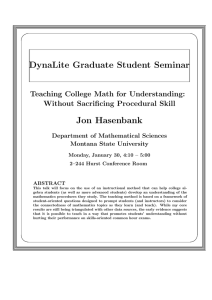I A T S
advertisement

IMPROVING ACADEMIC ACHIEVEMENT THROUGH IMPROVING SCHOOL CLIMATE AND STUDENT CONNECTEDNESS David Osher, Elizabeth Spier, Kimberly Kendziora, & Cindy Cai American Institutes for Research Presented April 14, 2009 at the American Educational Research Association Annual Meeting, San Diego, CA Learning is more than a cognitive process. Research suggests that there are powerful social and emotional factors that affect learning (Becker & Luthar, 2002; Osher et al. 2008). These include how the student experiences his or her relationships with the teachers and other students as well as how students experience the care and support provided to teachers and other staff. Social and emotional factors students’ influence abilities to attend to learning, their ability to direct their learning, and their engagement in learning activities. These factors also influence teachers’ abilities to connect with, challenge, and support their students. The research presented here builds upon a suvey developed for the Association of Alaska School Boards (AASB) in order to evaluate the Alaska Initiative for Community Engagement (Alaska ICE), the goal of which was to engage adults in creating positive changes to promote the academic progress and overall wellbeing of their young people. As one component in the longitudinal evaluation of Alaska ICE, AIR developed a school district survey for students and school staff. The data from the survey provide schools with information about how their students and staff perceive their school climate and how students perceive their connectedness to school each year. The survey is currently being implemented in 38 school districts. This research is part of a larger research program which includes the collection and analyses of survey data regarding how students experience the social and emotional conditions for learning, and the relationship of these conditions and how they experience these conditions to academic outcomes of interest (e.g., Kendziora, Osher, & Chinen, 2008; Osher & Kendziora, forthcoming, Spier, Osher, Cai, 2008). What Are School Climate and Connectedness? School climate refers to factors that contribute to the tone in schools, and the attitudes of staff and students toward their schools. Positive school climate is associated with well-managed classrooms and common areas, high and clearly stated expectations concerning individual responsibility, feeling safe at school, and teachers and staff that consistently acknowledge all students and fairly address their behavior. School connectedness refers to students’ school experiences and their perceptions and feelings about school. This includes feeling that they are a part of the school, that adults at school care about them personally, that their learning matters and is a high priority, that they are close to 1 people at school and have supportive relationships with adults, and that teachers and staff consistently treat them with respect. School climate is related to school connectedness, because without a positive and welcoming school climate, students are unlikely to experience connectedness. Research has found that the most powerful predictors of school connectedness are related to school climate (e.g., Abbott et al, 1998). Climate can be thought of as assets external to students that indicate or promote connectedness, whereas connectedness can be thought of as internal assets such as students’ feelings, perceptions, and beliefs. A growing body of research shows an association between the level of school climate and the level of connectedness and academic achievement (e.g., Klem & Connell, 2004). The purpose of the current analyses was to step beyond associations and look at the relationship between observed changes in school climate and connectedness and the change in student achievement. This analysis asked whether changes in student and staff perceptions of school climate and changes in student feelings of connectedness to their school were associated with changes in student achievement over time How were School Climate and Connectedness Measured? The School Climate and Connectedness Survey (SCCS) was administered to staff and students in a small number of Alaska school districts in 2005, and a larger number in 2006 and 2007. Students in grades 5 through 12 were eligible to participate in the SCCS. The 2006 SCCS sample was made up of 3,453 staff and 24,732 students from 148 schools across 15 districts. The 2007 SCCS sample was made up of 3,315 staff and 22,411 students from 150 schools across 14 school districts. A total of 114 schools from 11 districts participated in both the 2006 and 2007 SCCS. The sample was not selected to be representative of the state as a whole, but did include a large number of participants from a broad variety of schools. For example, in 2007, 27.34 percent of all Alaska students from fifth through twelfth grade participated in the study.1 The items on the student version of the SCCS yielded scale scores in the following areas: • High Expectations • Respectful Climate • School Safety • School Leadership and Involvement • Peer Climate • Caring Adults • Community Involvement (2007 only) • Social and Emotional Learning • Student Delinquent Behaviors • Student Drug and Alcohol Use 1 Source: Alaska Department of Education and Early Development, District Enrollment as of October 1, 2006, accessed September 13, 2007 at http://www.eed.state.ak.us/stats/DistrictEnrollment/2007DistrictEnrollment.pdf 2 Student scale scores were also combined into two composite scores: Overall Climate (made up of High Expectations, School Safety, and School Leadership), and Overall Connectedness (made up of Respectful Climate, Peer Climate, Caring Adults, and Community Involvement). All SCCS scores were on a 1 to 5 scale. The reliability for each scale (Chronbach’s alpha) is a number between 0 and 1 that reflects the degree to which the items in a scale are internally consistent — the degree to which they tend to correlate with each other better than with other items on the survey. Internal reliability for these scales ranged from .59 to .94 in 2006, and from .64 to .87 in 2007. Student scale scores were not computed at the school level for schools with fewer than six participating students. The items on the staff version of the SCCS yielded scale scores in the following areas: • School Leadership and Involvement • Staff Attitudes • Student Involvement • Respectful Climate • School Safety • Parent and Community Involvement • Student Delinquent Behaviors • Student Drug and Alcohol Use. An Overall Climate composite score was calculated by combining the means of School Leadership, Respectful Climate, Staff Attitudes, Parent and Community Involvement, Student Involvement, and School Safety, plus (reverse-coded) Student Delinquency and Student Drug and Alcohol Use scores. Internal consistency reliability for these scales ranged from .65 to .90 in 2006, and from .78 to .94 in 2007. Staff scale scores were not computed for schools with fewer than six participating staff. How was Student Achievement Measured? The Alaska Department of Education and Early Development’s Standards Based Assessment (SBA) is used to measure academic achievement across the state of Alaska. The SBA is given annually to all Alaska students in grades 3 through 10, and measures student performance in three areas: Reading, Writing, and Mathematics. Test results are reported for each student as scale scores in each of the three subject areas, and students are also categorized in one of four proficiency categories for each subject (Advanced, Proficient, Below Proficient, or Far Below Proficient). Results of the SBA are used to determine if a school is making Adequate Yearly Progress under the No Child Left Behind legislation. For this study, we defined student achievement at the school level in each subject area as the percentage of students who scored at the Proficient or Advanced level. For each school, we calculated a weighted mean percent proficient for each subject area for each year by combining percent proficient at each grade level assessed in that school, and weighting by the number of participants completing the SBA for that grade in that subject. Because students participated in the SCCS anonymously, it was not possible to link individual SCCS data and SBA scores. 3 How did School Climate and Connectedness Relate to Student Achievement? Overall, participating schools increased the percentage of students achieving proficiency in each of the three SBA subjects from 2006 to 2007. There were 105 schools that had proficiency data from both 2006 and 2007. See Table 1 for a description of SBA scores for participating schools. Table 1 SBA Scores for Participating Schools from 2006 to 2007 Reading Writing Mathematics Percent of Students Mean = 80.1 Mean = 77.6 Mean = 70.6 Proficient 2006 SD = 11.1 SD = 13.1 SD = 14.5 Range 40.7 to 95.4 Range 27.2 to 95.2 Range 28.2 to 95.0 Change in Percent Mean = +3.9 Mean = +0.2 Mean = +4.3 Proficient 2006 to 2007 SD = 5.6 SD = 6.9 SD = 5.6 Range –8.0 to +40.0 Range –21.0 to +40.0 Range –31.0 to +27.0 We conductedrepeated measures analyses to examine the changes in student SBA performance on the Reading, Writing, and Mathematics exams from 2006 to 2007 in relation to staff and student SCCS scale scores from 2006 to 2007. In the repeated measures analyses, the percentages of students at or above proficiency as measured by the SBA from each school at Time 1 (2006) and Time 2 (2007) served as the dependent variable, and the difference scores between 2006 and 2007 SCCS scale scores served as covariates. Difference scores were used as covariates in the models because the main focus of the analyses was to examine the relationship between changes in student achievement and changes in school climate between 2006 and 2007. In addition, using difference scores instead of scale scores from 2006 and 2007 separately as covariates in the model provided more degrees of freedom and therefore more statistical power. Separate repeated measures analysis was conducted for each outcome measure (i.e., Reading, Writing, Mathematics) and the same set of covariates were used in each model. All analyses were conducted at the school level. Results are presented in Tables 2, 3 and 4, with covariates consisting of SCCS scales that attained or approached a significant level of relationship with the achievement measure. In the area of Reading, changes in student ratings for Caring Adults and ratings for Overall Connectedness from 2006 to 2007 were each positively associated with changes in SBA Reading scores. Changes in student ratings for Peer Climate approached a significant positive relationship with changes in SBA Reading scores. See Table 2 for details. Table 2 Relationships between School Climate and Connectedness and Reading Achievement Reading Covariates Used Wilks’ Lambda F- value P-value Students: Caring Adults 0.95 4.05 < .05 Students: Overall Connectedness 0.89 9.61 < .01 Students: Peer Climate 0.96 3.16 < .10 In the area of Writing, changes in student ratings for Caring Adults and for Overall Connectedness from 2006 to 2007 were each positively associated with changes in SBA Writing 4 scores. Staff ratings for student Substance Use were negatively associated with changes in SBA Writing scores. A negative association means that a decrease in Substance Use was associated with an increase in SBA Writing scores. Changes in student ratings for Social and Emotional Learning approached a significant positive relationship with changes in Writing scores. See Table 3 for details. Table 3 Relationships between School Climate and Connectedness and Writing Achievement Writing Covariates Used Wilks’ Lambda F- value P-value Students: Caring Adults 0.94 5.94 < .05 Students: Overall Connectedness 0.95 4.43 < .05 Staff: Student Substance Use 0.86 13.16 <.01 Students: Social and Emotional Learning 0.97 2.89 < .10 In the area of Mathematics, changes in student ratings for Caring Adults, Peer Climate and Overall Connectedness from 2006 to 2007 were positively associated with changes in SBA Mathematics scores. Changes in staff ratings for Student Involvement from 2006 to 2007 were also positively associated with changes in SBA Mathematics scores. Changes in staff ratings for student Substance Use were negatively associated with changes in SBA Mathematics scores, so that a decrease in reported substance use was associated with an increase in Mathematics scores. Changes in student ratings for Social and Emotional Learning approached a significant positive relationship with changes in SBA Mathematics scores. And staff ratings for Staff Attitudes approached a significant positive relationship with changes in SBA Mathematics scores. See Table 4 for details. Table 4 Relationships between School Climate and Connectedness and Mathematics Achievement Mathematics Covariates Used Wilks’ Lambda F- value P-value Students: Caring Adults 0.95 4.25 < .05 Students: Peer Climate 0.95 4.38 < .05 Students: Overall Connectedness 0.89 10.32 < .01 Staff: Student Involvement 0.95 4.25 < .05 Staff: Student Substance Use 0.95 4.17 < .05 Students: Social and Emotional Learning 0.96 3.14 < .10 Staff: Staff Attitudes 0.96 3.20 < .10 In sum, changes in several aspects of school climate and connectedness were positively associated with changes in student achievement in Reading, Writing and Mathematics. Discussion These results show that, not only are several aspects of school climate and connectedness related to student achievement, but positive change in school climate and connectedness is related to significant gains in student scores on statewide achievement tests, at least when such gains are made. These findings move beyond simply knowing that schools with good climate and 5 connectedness are likely to have good student achievement, and that schools with poor climate and connectedness are likely to have poor student achievement. They show that whether a school starts with high or low school climate and connectedness, and high or low achievement scores, changing that school’s climate and connectedness for the better is associated with increases in student performance in reading, writing, and mathematics. These findings add to an increasing body of literature that suggests that how students experience the school environment affects their academic performance (Kendziora, Osher, & Chinen, 2008; Osher et al, 2008). However, these findings should not be read to suggest that a focus on academic instruction is unimportant. Rather, as Lee and her colleagues (1999) suggest (based upon analyses of Chicago data sets), academic improvement is enhanced when schools combine student support and academic press. By providing students with support that addresses their social and emotional needs and by building strong social and emotional conditions for learning, educators can improve learning outcomes that cannot be addressed through instruction alone. Social and emotional support can include establishing a caring community where students feel welcome and supported, using relational approaches to discipline, providing students with academic and behavioral supports to help them realize high academic and behavioral standards, and building the social and emotional skills of students and staff so that they can manage their emotions and relationships and work together in a productive manner. References Abbott, R. D., O'Donnell, J., Hawkins, J. D., Hill, K. G., Kosterman, R., & Catalano, R. F. (1998). Changing teaching practices to promote achievement and bonding to school. American Journal of Orthopsychiatry, 68, 542–552. Becker, B. & Luthar, S. (2002), Social-Emotional Factors Affecting Achievement Outcomes Among Disadvantaged Students: Closing the Achievement Gap. Educational Psychologist, Vol. 37, No. 4, Pages 197-214; Klem, A., & Connell, J. (2004). Relationships matter: Linking teacher support to student engagement and achievement. Journal of School Health, 74, 262–273. Kendziora, K., Osher, D., Chinen, M. (2008). Student connection research: Final narrative report to the Spencer Foundation. Lee, V., Smith, J., Perry, T., & Smylie, M. A. (1999, October). Social support, academic press, and student achievement: A view from the middle grades in Chicago. Chicago: Consortium on Chicago School Research, Chicago Annenberg. Osher, D. & Kendziora, K. (In Press). Building Conditions for Learning and Healthy Adolescent Development: Strategic Approachin B. Doll, W. Pfohl, & J. Yoon (Eds.) Handbook of Youth Prevention Science. New York: Routledge. Osher, D., Sprague, J., Weissberg, R. P., Axelrod, J., Keenan, S., Kendziora, K., & Zins, J. E. (2008). A comprehensive approach to promoting social, emotional, and academic growth in contemporary schools. In A. Thomas & J. Grimes (Eds.) Best practices in school psychology V, Vol. 4 (pp. 1263–1278). Bethesda, MD: National Association of School Psychologists. 6




